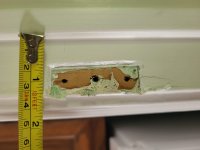MTbassbone
Member
- Joined
- Oct 24, 2016
- Messages
- 62
Hi all, I removed some louvered doors from doorways going to and from our kitchen, and am now left with the hinge mortises on the door jambs. The door hinges were smaller, and I am concerned if I try to make a dutchman this size it will not look good or maybe not even hold. I am wondering if it would be better to make the mortise larger either by hand (chisel) or with a router/homemade jig. Anyone have experience with this type of situation?

